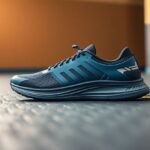
Explore the groundbreaking advancements in running footwear technology that have dramatically changed the landscape of performance enhancement for endurance athletes. These developments are not simply minor updates; they signify major breakthroughs that can revolutionize your running experience and elevate your performance to new heights.
The field of performance optimisation in endurance running has been significantly transformed by advanced footwear technology, unlocking extraordinary opportunities for you to maximise your athletic potential. Discover how cutting-edge shoe designs can dramatically reduce your metabolic expenditure while simultaneously enhancing your running economy. With the integration of carbon fibre plates and revolutionary midsole materials, these advanced footwear options offer exceptional energy return mechanisms that could lead to a reduction in your oxygen consumption by as much as 4%. Whether you are a competitive athlete or an enthusiastic hobbyist, understanding these biomechanical advancements can empower you to make informed decisions about your running shoes and potentially improve your race times.
 Continue reading to dive deeper into the complex dynamics of running footwear that promise to enhance your performance:
Continue reading to dive deeper into the complex dynamics of running footwear that promise to enhance your performance:
Unlocking Maximum Energy Return: Understanding the Science of Advanced Running Shoes
The advanced technology embedded in running shoes leverages sophisticated biomechanical principles to maximise energy transfer during each stride. Innovative design elements are meticulously crafted to work in unison, minimising metabolic expenditure and creating a highly efficient system that boosts running performance through strategic material engineering and optimised geometrical arrangements. By focusing on energy return mechanics, these shoes provide runners with a significant edge in both performance and stamina, allowing for longer running sessions with reduced fatigue levels.
Exploring the Impact of Carbon Fibre Plate Curvature on Running Efficiency
Carbon fibre plates are designed using precise geometric engineering principles, enabling them to redirect kinetic energy effectively throughout the running cycle. Optimal curvature angles between 12°-15° facilitate maximum energy storage and return, with finite element modelling illustrating an impressive energy return efficiency of up to 93% in prototype designs. These expertly engineered plates act like springs, significantly lowering muscular effort during the toe-off phases, enabling runners to conserve energy over longer distances, ultimately enhancing both endurance and overall performance.
Assessing Innovations in Midsoles: TPU vs. EVA
Material selection is crucial in determining the performance of running shoes, with thermoplastic polyurethane (TPU) emerging as a standout midsole technology. Comparative analyses show TPU’s considerable advantages in energy return and shock absorption, providing runners with improved biomechanical efficiency under various running conditions. Choosing between TPU and EVA foam is critical for athletes seeking to enhance their performance while minimising injury risks during both training and competitive events.
| Energy Return | 18% higher in TPU |
| Oxygen Consumption Reduction | 2.4% lower with TPU |
A thorough examination of midsole materials reveals intricate performance characteristics. TPU demonstrates remarkable durability compared to traditional EVA foam, maintaining consistent mechanical properties even after thousands of compression cycles. Runners benefit from more reliable energy return, decreased fatigue, and enhanced performance during long-distance runs through advances in material science, which can significantly influence their overall training outcomes and competitive successes.
| Impact Absorption | TPU absorbs 37% more force |
| Rebound Elasticity | 89% maintained across 50,000 cycles |
 Delve deeper as we explore the effects of advanced footwear technology on metabolic efficiency:
Delve deeper as we explore the effects of advanced footwear technology on metabolic efficiency:
Assessing Metabolic Efficiency: Understanding Who Benefits Most from Advanced Footwear
The advantages of advanced footwear technology do not apply uniformly to all runners. Gains in metabolic efficiency can differ dramatically among various demographic groups, with factors such as gender, age, and individual biomechanics playing crucial roles in the enhancement of performance. Research has unveiled intricate patterns of metabolic response, indicating that the benefits of super shoes extend beyond basic performance metrics to include complex physiological adaptations tailored to each runner’s biomechanical profile.
Analyzing Gender-Specific Performance Enhancements
Research shows that female runners experience a 3.2% improvement in metabolic power, compared to 4.2% in their male counterparts, hinting at complex neuromuscular adaptations. Insights into pelvic kinematics reveal a 14% greater reduction in hip adduction angle for women when using advanced footwear, which may explain the subtle differences in metabolic gains observed between genders. Understanding these variances can assist in the development of tailored training programs and footwear selections, optimising performance for each gender.
Examining Age-Related Benefits for Endurance Athletes
Masters athletes, particularly those aged 40 and older, show a 2.8% greater reduction in oxygen cost when using super shoes, likely compensating for reduced tendon elasticity. Analysis of tibial loading indicates a 12% cumulative stress reduction per kilometre for older runners, highlighting significant benefits for both injury prevention and performance sustainability. These findings emphasise the crucial role of advanced footwear technology in extending the competitive lifespan of older athletes.
The advantages of advanced footwear technology for older runners extend well beyond simple performance metrics. Biomechanical studies reveal that older runners can experience more pronounced adaptations due to compensatory mechanisms. Reduced tendon stiffness and altered muscle recruitment patterns interact synergistically with shoe technology to create a distinct performance enhancement profile. Specifically, the energy return mechanisms provided by carbon plates appear to counteract age-related biomechanical inefficiencies, potentially prolonging competitive running careers by alleviating the physiological limitations typically faced by aging athletes.
Continue reading to discover more about how advanced footwear technology affects injury risks:
Analyzing the Impact of Running Footwear on Injury Risk
Advanced footwear technology introduces complex biomechanical interactions that require careful consideration of potential injury risks. Runners must thoughtfully navigate the balance between performance enhancement and physiological adaptation. Longitudinal studies have shown subtle yet significant changes in muscular recruitment patterns, joint loading, and proprioceptive feedback when transitioning to high-performance running shoes, underscoring the importance of a comprehensive training and recovery strategy.
Injury Risk Analysis: The Cost of Enhanced Performance
Research indicates a 9% increase in strain rates on the Achilles tendon among users of super shoes during high-intensity workouts. Plantar pressure mapping reveals a 22% increase in loading on the forefoot compared to traditional trainers, particularly during challenging terrains like downhill running. These results suggest that while metabolic efficiency may improve, runners should implement targeted strength and conditioning protocols to mitigate potential injury risks and ensure long-term athletic health.
Adapting Training Protocols for Optimal Gait Adjustments
Your biomechanical response to advanced footwear necessitates strategic modifications in your training regimen. Gait retraining is essential for optimising the unique energy return mechanisms found in carbon-plated shoes. Runners must focus on developing neuromuscular patterns that are in sync with the biomechanical designs of their footwear, potentially reducing injury risks while maximising performance benefits.
Comprehensive gait adaptation strategies encompass a variety of methods to effectively integrate advanced footwear technology. Biomechanical assessments indicate that runners typically require around 6-8 weeks of progressive training to fully adapt to the distinct mechanical properties of super shoes. This adaptation period includes targeted eccentric strengthening exercises, modified interval training approaches, and careful monitoring of lower limb biomechanics. Professional athletes and committed runners can greatly benefit from periodic 3D gait analysis to track subtle changes in movement patterns, ensuring optimal alignment of advanced footwear technology with individual biomechanical characteristics.
 Look ahead as we explore the future of footwear technology and its implications for runners:
Look ahead as we explore the future of footwear technology and its implications for runners:
Exploring Future Innovations in Running Footwear Technology
Emerging technologies are poised to redefine the design of running shoes, pushing the boundaries of biomechanical efficiency and performance optimisation. Cutting-edge research is concentrating on personalised solutions that adapt to individual biomechanics, employing advanced materials, computational modelling, and integrated sensor technologies to usher in a new generation of intelligent footwear tailored specifically for elite athletes.
Revolutionising Footwear Design through 3D Printed Midsoles
Optimisation algorithms for lattice structures now allow for precise alterations in stiffness that correspond to individual foot pressure maps. Prototype testing has indicated an additional 5.1% in metabolic savings compared to standard mass-produced models, with computational design facilitating unprecedented customisation of midsole geometries to enhance energy return and reduce biomechanical stress. This innovative approach ensures that every runner can achieve optimal performance tailored to their unique physical attributes.
Integrating Smart Technologies for Enhanced Performance Tracking
Innovative sensor technologies are transforming running shoes into advanced performance monitoring devices. Real-time ground reaction force feedback systems can facilitate a 1.9% reduction in oxygen costs by allowing micro-adjustments in cadence, providing runners with immediate biomechanical insights during training and competition. These advancements are essential for athletes looking to refine their technique and improve performance metrics.
Advanced sensor integration represents a significant advancement in performance monitoring technology. Multi-axis accelerometers, pressure-sensitive matrices, and embedded microprocessors now capture intricate biomechanical data with unparalleled accuracy. These intelligent systems analyse gait mechanics, impact forces, and energy expenditure in real-time, offering runners comprehensive insights into their movement patterns. Machine learning algorithms can now predict potential injury risks, optimise training loads, and recommend personalised technique modifications based on detailed movement analysis, transforming running shoes from passive equipment into dynamic tools for performance optimisation.
Finally, gain a comprehensive understanding of the transformative landscape shaped by advanced footwear technology in endurance running:
Embracing the Future of Advanced Footwear Technology in the World of Running
In conclusion, you have explored the transformative journey of advanced footwear technology in the realm of endurance running. Your insights now encompass how innovative design elements such as carbon plates and high-performance midsole materials can significantly lower metabolic costs while boosting running efficiency. By leveraging scientific knowledge, you can recognise that these shoes provide more than just marginal gains—they represent a paradigm shift in athletic performance. Your investment in such technology may lead to improved running economy, decreased energy expenditure, and optimised biomechanical responses across a diverse range of athletic populations.
The Article Biomechanical Efficiency of Advanced Footwear Technology: Metabolic Cost Reduction and Performance Enhancement in Endurance Running appeared first on My Shoes Finder.
The Article Biomechanical Efficiency in Advanced Footwear for Runners Was Found On https://limitsofstrategy.com
The Article Biomechanical Efficiency: Advanced Footwear for Runners First Appeared ON
: https://ad4sc.com






Comments are closed